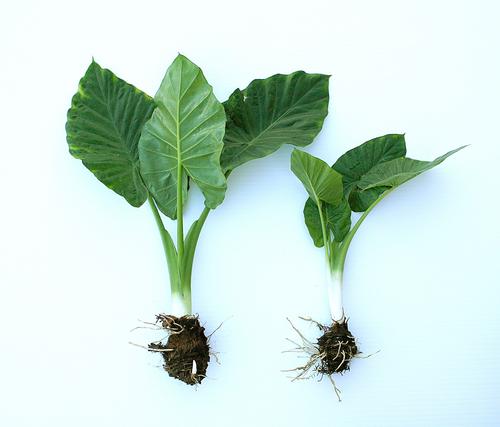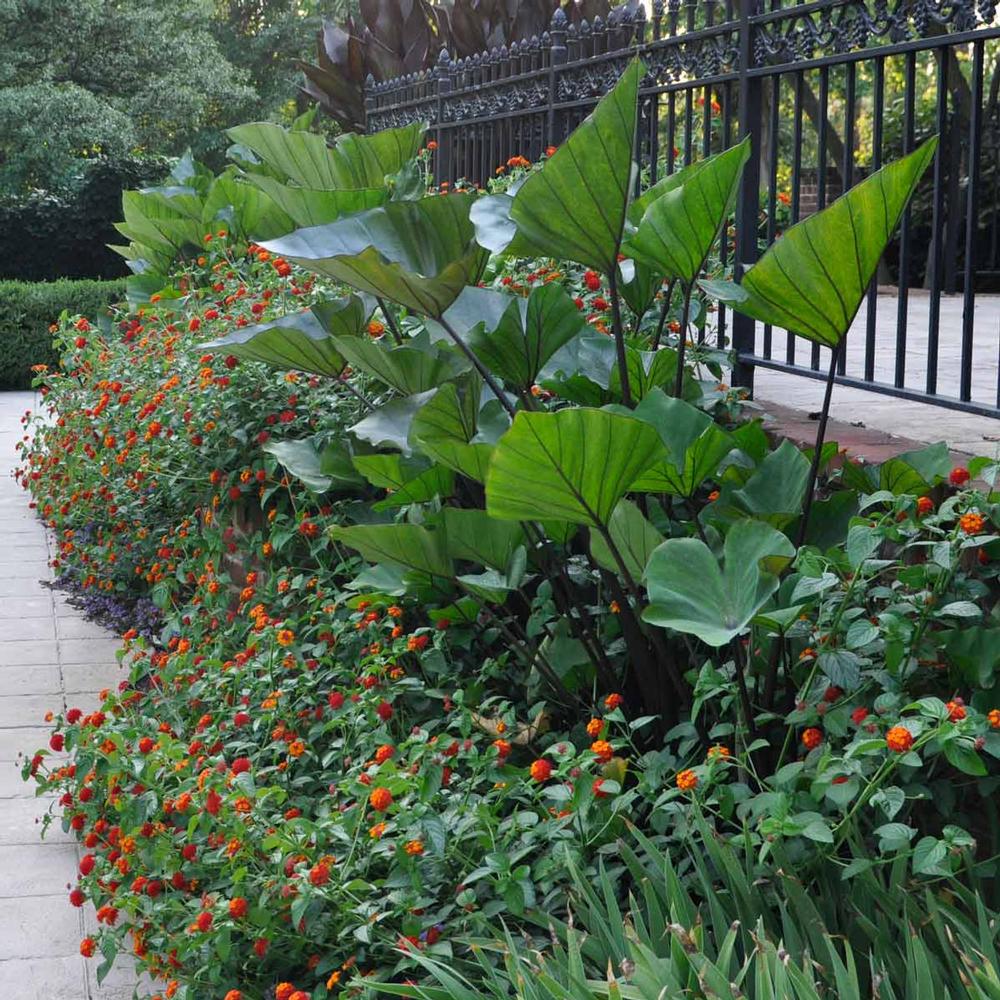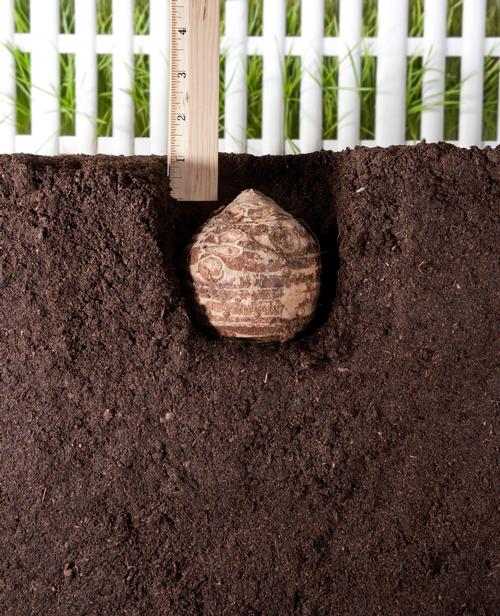Elephant Ears
Zone: Elephant ears are tropical plants. In zones 9-11 they can be grown outdoors year-round. In cooler areas (zones 3-8) the bulbs should be planted outdoors in the spring, after all danger of frost. To find your USDA Hardiness Zone, check the map here.
All About Elephant Ears
Your Guide to Planning, Planting, and Growing Elephant Ears
Alocasias and colocasias, better known as elephant ears, are impressive tropical plants that are prized for their dramatic foliage. Their immense, heart-shaped leaves can measure up to 2 feet across, with foliage colors ranging from lime green to almost black. Elephant ears can easily hold their own as a solo plant in the garden or in a large container. They also combine beautifully with other summer bulbs and flowering annuals.
Upright elephant ears (Alocasia) usually have shiny leaves and the tip of the leaf points upward. They can be grown both indoors and out. Colocasia typically have a more spreading habit. Their leaves often have a velvety surface texture and the tip of the leaf usually points either down or outward.

Start with a Better Plant
It’s easy to see the difference in quality when you compare two elephant ear tubers side by side. As with other bulbs, elephant ear tubers are graded by size. We offer large tubers that are 9-11 inches in circumference. They grow into big plants with strong stems and abundant foliage. Smaller tubers (like the one on the right) produce smaller plants with less foliage. Note that a healthy elephant ear tuber will feel firm and heavy, and have a dry exterior.

Plan for Success
Sun or Shade: Elephant ears will grow in sun or shade. If you grow them in a hot, sunny location, be sure they get a little shade during the middle of the day.
Zone: Elephant ears are tropical plants. In zones 9-11 they can be grown outdoors year-round. In cooler areas (zones 3-8) the bulbs should be planted outdoors in the spring, after all danger of frost. To find your USDA Hardiness Zone, check the map here.
When to Plant: Elephant ear tubers will not grow in cold soil. Wait to plant them outdoors until the soil temperature is at least 65ºF. In northern climates this will be early June. To get a jump on the season, elephant ears may be started in pots indoors, 4 to 6 weeks before you plan to put them outside. Grow them under lights or in a warm, sunny window.

How to Plant Elephant Ears
1. Wait until the soil is warm and there’s no danger of frost. Loosen the soil 8″ deep. Then dig a hole about 5″ deep.
2. Set the tuber in the hole, pointy side up. The top of the tuber should be about 1” below the soil surface.
3. Cover the tuber with soil and water thoroughly.

Planting Tips and What to Expect
Elephant ear tubers can be very slow to sprout. Depending on when and where they are planted, it may take a month or more before you see any sign of growth. While waiting for the bulb to sprout, it’s important to water sparingly.
Plant elephant ears in rich, well drained soil. Before planting, improve the soil with compost or topsoil to add nutrients and improve the soil’s water-holding capacity.
For elephant ears to reach their full size, they need consistent moisture throughout the summer. They also benefit from an application of liquid fertilizer every 2-3 weeks.
In warm, frost-free climates (zones 9-11), elephant ears can be grown outdoors year-round. In cooler areas (zones 3-8) they are usually grown as annuals. When the tubers are planted in late spring, they will become large, impressive plants within just a few months. Be sure to give them plenty of room to reach their full potential.

Where to Plant Elephant Ears
Containers, Patios and Decks Elephant ears are a perfect solution for shady porches, decks and other places around your home that are not in full sun. The large, heart-shaped leaves add a tropical feel to pools, spas and water gardens.
Walls and Fences Planting elephant ears next to a wall or fence protects the plants from wind and too much sun. It also puts their big leaves to work, softening straight lines and adding visual interest to blank walls.
Entryways Add a “wow” element to your front door by planting elephant ears in a large container. You can count on them to make a big statement and impress guests. Plant elephant ears on their own or pair them with other bold, heat-loving foliage plants such as caladiums and coleus.
Screening The broad leaves and tall stems of elephant ears can be used to screen an unwanted view or define a space in your garden. Planting them along a property line or around an outdoor living area will make your yard feel more private.
Indoor Houseplant Upright elephant ears may also be grown indoors as long the plants get enough light and water. Their attractive foliage can be an exciting feature all year round.

Caring For Elephant Ears in the Fall
Elephant ears are winter hardy in zones 9-11 and the tubers will not survive freezing temperatures. In colder areas, you can either treat elephant ears as annuals and discard them at the end of the growing season, or you can store the tubers indoors and replant them next year.
If you want to store alocasia or colocasia tubers from one year to the next, dig them up in the fall before temperatures drop below 40°F. Dig carefully, starting about a foot away from the center of the plant. Lift the entire plant out of the ground (or out of the pot) and move it to a warm, dry place where it will be protected from frost. Once the root ball is dry, cut the stems short and use your hands to pull away most of the soil. Allow the tuber to continue drying. When the foliage is crispy-dry, pull it away from the tuber and discard. Wrap each tuber separately in paper and store in a warm, dark, dry place at 50-60ºF.
Upright elephant ears (Alocasia) may be grown as a houseplant. Keep the plant in bright, indirect light. Water regularly, making sure the soil doesn’t become soggy.
To see our selection of elephant ears click HERE. To see a video about digging, splitting and storing elephant ear bulbs click HERE.
Elephant Ears

How to Plant, Grow, and Care for Elephant Ear Plants
Sign up for daily gardening advice and tips
The dramatic elephant ears plant is a large, tropical foliage plant with magnificent, heart-shaped or arrow-shaped leaves. In colder regions, they need to be dug up and stored before winter arrives. Here’s how to grow and care for elephant ears in your garden.
About Elephant Ears
Elephant ear belongs to the genus Colocasia, which are tuberous, frost-tender perennials from tropical Asia. You may be familiar with one species, Colocasia esculenta, by its other name: taro. Taro is an edible root vegetable enjoyed in much of tropical Africa and Asia.
These plants are accustomed to wet areas with the filtered sun of a tropical forest. Therefore, they prefer moist soils and also partial shade. They are good for wet areas along creeks, rain gardens, or low-lying areas.
If you grow elephant ears in a garden bed, that’s perfectly fine as long as they receive regular moisture and don’t dry out (especially in hot summers)! Elephant ears look great in a container with other summer bulbs and/or annuals.
In USDA Hardiness Zones 7 to 11, elephant ears can be left outside year-round and are treated as perennials. In colder climates, they are typically treated as annuals and discarded at the end of the growing season. However, you could also dig up the tubers after the first fall frost, store them indoors, and replant them next year after the last spring frost.
Elephant ear leaves can reach lengths of 3 feet on top of 3- to 7-foot stems. The leaves usually have prominent veins, and their colors range from lime green to almost black.